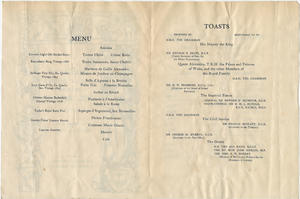Search the Special Collections and Archives Portal
Search Results
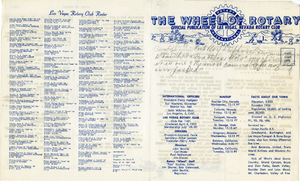
The Wheel of Rotary Las Vegas Rotary Club newsletter, November 17, 1949
Date
Archival Collection
Description
Text

Transcript of interview with Millicent Rosen by Barbara Tabach, June 23, 2015
Date
Archival Collection
Description
Until her passing in 2017, Millicent (Siegel) Rosen was the living link to Benjamin “Bugsy” Siegel, one of Las Vegas’ most notorious links to the Jewish mob. A steadfastly independent woman herself, Millicent recalls Benjamin as a loving father to her and her younger sister. She is proud of his status as a Las Vegas visionary, though she affixes a footnote that the city of today might not be to his liking. She includes a few anecdotes about common names of the early days, including Meyer Lansky who walked her down the aisle when she married Jack Rosen. They had three children: Benjamin, Cindy, and Wendy. Millicent moved to Las Vegas to be with her daughter and her family in about 2000 and cherished her role as a grandmother. Always an artist at heart, Millicent once painted canvases for needlepoint and in 2015 promoted her clothing line.
Text

Transcript of interview with Elizabeth "Betty" Krolak by Irene Rostine, September 26, 1995
Date
Archival Collection
Description
In 1962, Elizabeth “Betty” Krolak moved from the Midwest to Las Vegas with her husband and six children. Not only would the drier desert climate benefit her youngest daughter’s health due to asthma, but the family hoped the Las Vegas economy would be beneficial for their future. Prior to her arrival in Las Vegas, Betty worked briefly as a secretary for the New York Central Railroad before becoming a stay-at-home mom and active member of the PTA. Upon their arrival in Las Vegas, Betty’s husband enrolled in a real estate class, but was unable to complete the program. Betty, not wanting to waste the $80 they had spent on the class, decided to attend in his place. This decision led to life changing events for Betty and her family over the next four decades. After taking the real estate class and passing the test, Betty became a licensed Nevada real estate broker in October of 1963. She initially went to work for Pyramid Realty and, in 1964, she opened her own office, Clark County Realty. After her divorce in 1967, Betty was left with “six hungry children” to feed and no child support or health insurance. She recalls how the benefits of being in real estate really became apparent during this period of her life. While real estate required long hours seven days a week, it also afforded a single mother flexibility that other careers would not have offered. Likewise, a woman could make more money in real estate in the 1960s and 1970s than most other careers provided, which was particularly important for Betty who was committed to raising her children without public assistance. Betty’s oral history chronicles the growth of the Las Vegas Board of Realtors which has grown into what today is the Greater Las Vegas Association of Realtors (GLVAR). She recalls how, in the 1960s, meetings took place in bowling allies and the primary role of the GLVAR was to provide networking opportunities and represent the Code of Ethics for realtors. However, the Board was dominated by males, with the role of women members confined to planning social events and arranging for refreshments. In 1968, Betty and several other women realtors set out to change this by initially establishing a local Women’s Council within the Board. In the years following, Betty became the first women to be an Executive Board Member. Today, more than half the members of the Executive Board are women. Betty’s oral history also speaks to many changes within the real estate industry over the past four decades, some positive and some not so positive. She recounts the 1960s to the 1980s, when casino workers’ main source of income came from tips which were often unreported, creating challenges in getting casino workers qualified for home loans because they did not have the ability to document their source of income. Likewise, single women had a hard time qualifying for home loans because they only had one income and, in those days, it rarely was enough to qualify for a mortgage on their own. Also during this period, realtors primarily focused on the resale market because builders wanted to work directly with buyers, but changes in the real estate market eventually led builders to realize the benefits of allowing realtors to sell new houses, too. During her career, Betty also experienced the rise of real estate franchises, beginning with Century 21’s arrival in Nevada, the development of Multiple Listing Service (MLS), changes to educational requirements, approaches to settling disputes, and new approaches to ethics violations. Perhaps the biggest change Betty’s oral history speaks to is the personal approach to selling real estate that has been lost over time. In the early days, brokers sold houses right alongside the sales agents. Today, however, regulations have placed brokers in a position where their primary role is to manage sales people, not sell houses. Also, realtors used to interact with other realtors, title company personnel, and mortgage lenders before technology, such as fax machines and computers, came along. In the early days, documents were transferred in person allowing people in the industry to get to know one another through these personal interactions. Today, everything is done electronically and it is rare to actually know the person on the other end. Selling real estate has lost a lot of its personal touch, according to Betty. In addition to being the mother of six children and running one of the largest real estate offices in the area, Betty also found time to give back to the community through her volunteer work with the Salvation Army. She was instrumental in establishing Southern Nevada’s Angel Tree project, which provides Christmas presents to children who otherwise would not receive them. She was also appointed by Governor Michael O’Callahan to the State of Nevada’s Real Estate Commission, making her the first woman to serve on the Commission. Betty’s career in real estate allowed her to witness and implement many changes that still impact the industry today. When Betty began her career, Las Vegas’ population was just over 45 thousand. By the mid-1990s Green Valley, Spring Valley, North Las Vegas, Summerlin, and Sun City had been developed and the Valley’s population exceeded 1 million people. Betty Krolak’s career merged with the real estate boom as she helped find homes for those who wanted to make Las Vegas their home. She made sure the real estate industry’s growth included women, training mechanisms, and ethics which continue to benefit realtors, home buyers, and home sellers to this day.
Text
C. A. Earle Rinker Photograph Collection of Goldfield, Nevada
Identifier
Abstract
The C. A. Earle Rinker Photograph Collection of Goldfield, Nevada (approximately 1900-1915) contains individual black-and-white photographic prints, photographic albums, black-and-white and tinted postcards, and photographic negatives that document the history of early twentieth century Goldfield, Nevada. The images include photographic prints of Goldfield and surrounding areas during its peak years of 1906-1910; postcards showing scenes of Goldfield, Tonopah, and other areas in central Nevada; and negatives that contain images of Rinker's family and homelife in Indiana and Illinois.
Archival Collection
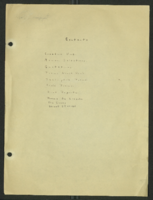
Mabel Hoggard: folder of materials related to her artistic interests
Date
Archival Collection
Description
Folder of materials from the Mabel Hoggard Papers (MS-00565) -- Personal papers file. This folder contains poems, quotations, essays, and short stories. It also contains Living Blues magazine (autumn 1971), a concert poster for vibraphonist Jay Hoggard, magazine clippings, visual art, letters, programs, and The Nixon Theater booklet (season 1903 and 1904, not digitized in its entirety).
Mixed Content
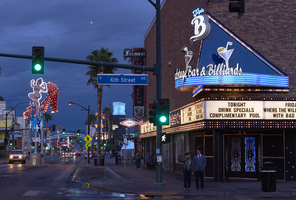
Photographs of Backstage Bar & Billiards, Las Vegas (Nev.), 2016-2017
Date
Archival Collection
Description
Site address: 601 Fremont St
Sign owner: DJ Lethal co-owned with DJ Scotty
Sign details: This building dates back to 1957. Triple B opened in 2012 as a billiard hall bar and concert venue. It is filled with a lot of Rock Memorabilia which includes a "turntable library" which they claim showcases over 8 decades of rock history. This location was furnished by rock outfitter Anvil Cases. This property got its name by being "backstage" to the adjoining Fremont Country Club.
Sign condition: 5- looks relatively new and still in great condition
Sign form: Variation of a Bull Nose Sign
Sign-specific description: Their entrance is on the corner of 6th (going South) and Fremont with a blue bull nose type sign in a triangle shape. The base of the triangle sign is right above the entrance. The triangle border has a blue (argon) strip with incandescents lining both sides of the neon tubing. At the base of the sign there is a blue (argon) curved platform (half circle placed adjoining to the base of the triangle). On this platform there are 5 separate strips of argon tubes. Above the platform states "Backstage Bar & Billiards" in white cursive channeled letters. Above the words Backstage and Billiards there are two martini glasses with a pool ball and flag in each glass. At the top of the triangle portion of the sign there is their logo "Triple B" in cursive with Triple in Blue and B in white. Below the bull nose sign there is a reader board that wraps around the building. This reader board is also lined with incandescent light bulbs. In the middle of the of the reader board there is a black background rectangle with 3 rhombus's lined in incandescent light bulbs in a design.
Sign - type of display: Neon, incandescent and reader board
Sign - media: Steel and Plastic
Sign - non-neon treatments: Reader Board
Sign animation: Flasher for incandescent light bulbs
Sign environment: Fremont East district East District, next to other bars and restaurants. This location is right across the street from the El Cortez. Also they claim to be "backstage" to the adjoining Fremont Country Club which inspired their name.
Sign manufacturer: Ultra Signs' recently bought out by Jones Las Vegas ( of Jones SIgns) who did not have records of this sign.
Sign - date of installation: 2012 when the bar opened
Sign - thematic influences: On Fremont many of the entrances are at the corner intersections, so the bull nose sign has been prominent design type to draw attention to the entrance of the company. This is remnant of the Golden Nugget and Binion's Horseshoe put up their bull nose signs in 1961.
Sign - artistic significance: The curved platform at the bottom of their bull nose sign looks like an old retro movie theater style sign platform that you would see in the 1940's/50's. Particularly with their reader board with incandescent light bulbs speaks to this era as well.
Survey - research locations: Assessor's page, triple B website http://www.backstagebarlv.com/ , Las Vegas Weekly Newspaper article https://lasvegasweekly.com/nightlife/lowball-diary/2012/dec/05/triple-b-fills-downtowns-watering-hole-hole/
Survey - research notes: Fremont Bars.com has a photo of their main sign being installed. http://www.fremontstreetbars.com/2012/11/29/welcome-to-the-neighborhood-backstage-bar-billiards/
Survey - other remarks: The Ultra Signs logo is visible on the left side of the sign.
Surveyor: Emily Fellmer
Survey - date completed: 2017-08-11
Sign keywords: Neon; Incandescent; Steel; Plastic; Flashing; Reader board; Bullnose; Marquee
Mixed Content
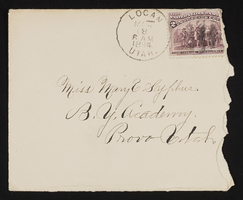
Letter and envelope from John M. Bunker, Logan Utah. to Mary Etta Syphus, Provo, Utah.
Date
Archival Collection
Description
From the Syphus-Bunker Papers (MS-00169). The folder contains an original handwritten letter, an envelope, a typed transcription of the same letter, and a copy of original letter attached.
Text
Sawyer, Lynnette Arvelo
Growing up just one block away from New York’s “Museum Mile” and surrounded by cultures from every corner of the world, it’s easy to say that Lynnette Arvelo Sawyer was destined to create her own museum dedicated to the cultures she grew up with. Lynette is a proud Puerto Rican and Afro-Latina from El Barrio of East Harlem in New York; her roots extend from the island of Puerto Rico to the Canary Islands off the coast of Africa.
Person


